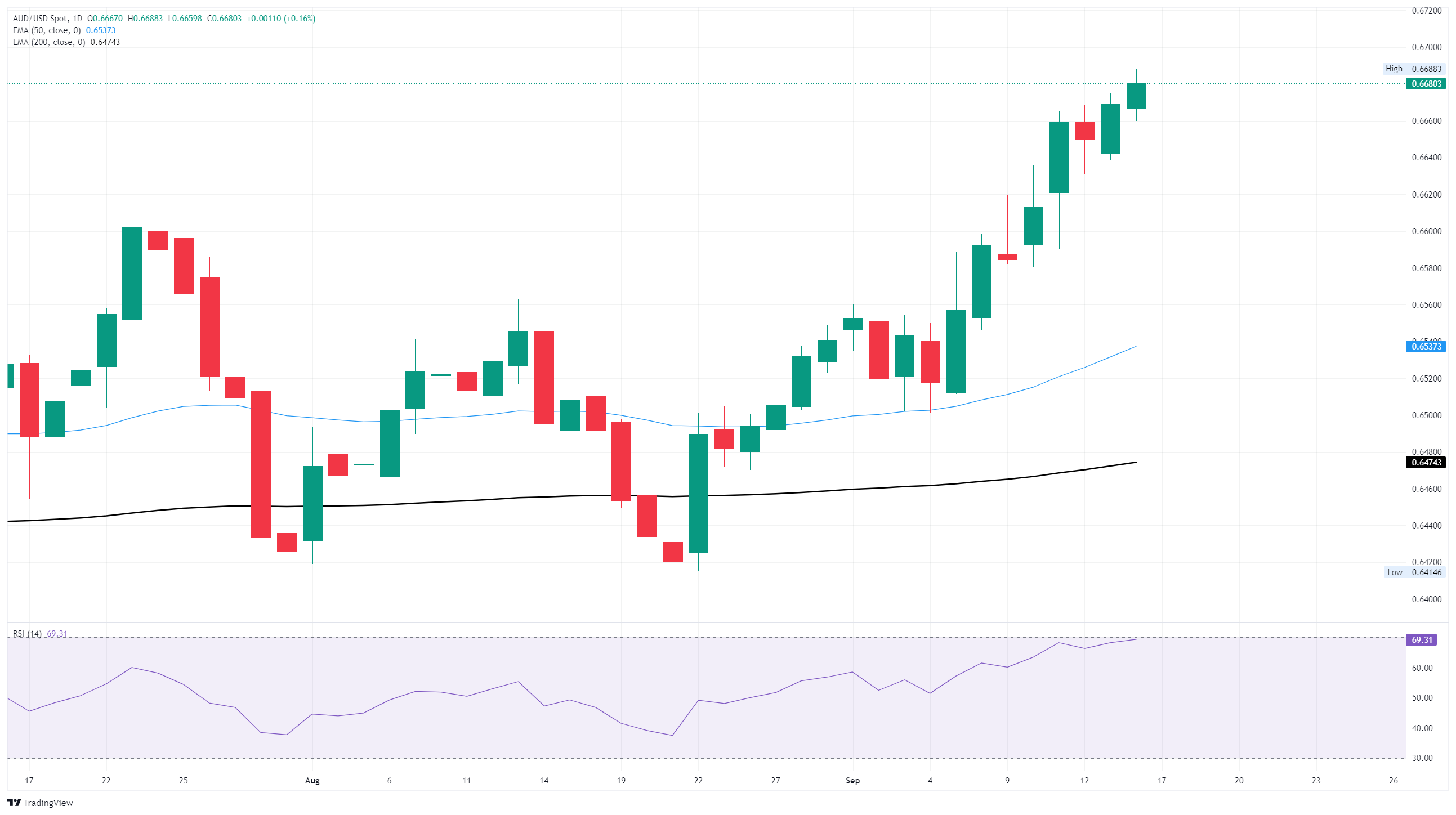AUD/USD continues bullish climb, taps 47-week high
- AUD/USD tested 0.6688 for the first time since last October.
- The US Dollar is broadly falling across the board ahead of the Fed’s upcoming rate call.
- The Fed is widely expected to kick off a fresh rate-cutting cycle on Wednesday.
AUD/USD extended into another bullish candle on Tuesday, extending the Australian Dollar’s (AUD) recent bull run against a broad-market Greenback selloff. AUD/USD tested 0.6688 for the first time in almost a year as the US Dollar (USD) crumbles ahead of the Federal Reserve’s (Fed) critical interest rate decision on Wednesday.
A quarter-point interest rate cut from the Fed is widely anticipated this week, and markets have piled into short Greenback bets while the Fed deliberates. However, the key datapoint for markets will be the Federal Open Market Committee’s (FOMC) update to its Summary of Economic Projections, also known as the dot plot, which outlines policymakers’ own interest rate expectations. Three straight rate cuts through the rest of the year are baked into interest rate markets, and investors will be looking for the Fed to play ball.
Australian labor market data will release on Thursday, but little market reaction is likely to come. Australian job creation is expected to continue to float between 20K and 25K, while the Unemployment Rate is forecast to hold steady at 4.2%.
AUD/USD price forecast
The Australian Dollar stepped into yet another green candle on Tuesday, chalking in a 4.27% rally bottom-to-top against the US Dollar since hitting a technical bottom near 0.6415. The Aussie has closed higher against the Greenback for all but two of the last seven consecutive sessions. Looking back longer-term, AUD/USD has shown a firm one-sided recovery, with the pair gaining ground or holding flat every single month except for one since hitting the floor last December.
AUD/USD daily chart

Australian Dollar FAQs
One of the most significant factors for the Australian Dollar (AUD) is the level of interest rates set by the Reserve Bank of Australia (RBA). Because Australia is a resource-rich country another key driver is the price of its biggest export, Iron Ore. The health of the Chinese economy, its largest trading partner, is a factor, as well as inflation in Australia, its growth rate and Trade Balance. Market sentiment – whether investors are taking on more risky assets (risk-on) or seeking safe-havens (risk-off) – is also a factor, with risk-on positive for AUD.
The Reserve Bank of Australia (RBA) influences the Australian Dollar (AUD) by setting the level of interest rates that Australian banks can lend to each other. This influences the level of interest rates in the economy as a whole. The main goal of the RBA is to maintain a stable inflation rate of 2-3% by adjusting interest rates up or down. Relatively high interest rates compared to other major central banks support the AUD, and the opposite for relatively low. The RBA can also use quantitative easing and tightening to influence credit conditions, with the former AUD-negative and the latter AUD-positive.
China is Australia’s largest trading partner so the health of the Chinese economy is a major influence on the value of the Australian Dollar (AUD). When the Chinese economy is doing well it purchases more raw materials, goods and services from Australia, lifting demand for the AUD, and pushing up its value. The opposite is the case when the Chinese economy is not growing as fast as expected. Positive or negative surprises in Chinese growth data, therefore, often have a direct impact on the Australian Dollar and its pairs.
Iron Ore is Australia’s largest export, accounting for $118 billion a year according to data from 2021, with China as its primary destination. The price of Iron Ore, therefore, can be a driver of the Australian Dollar. Generally, if the price of Iron Ore rises, AUD also goes up, as aggregate demand for the currency increases. The opposite is the case if the price of Iron Ore falls. Higher Iron Ore prices also tend to result in a greater likelihood of a positive Trade Balance for Australia, which is also positive of the AUD.
The Trade Balance, which is the difference between what a country earns from its exports versus what it pays for its imports, is another factor that can influence the value of the Australian Dollar. If Australia produces highly sought after exports, then its currency will gain in value purely from the surplus demand created from foreign buyers seeking to purchase its exports versus what it spends to purchase imports. Therefore, a positive net Trade Balance strengthens the AUD, with the opposite effect if the Trade Balance is negative.

